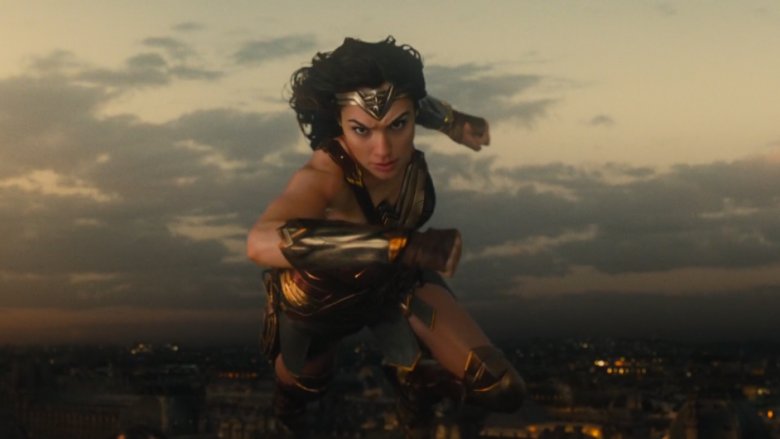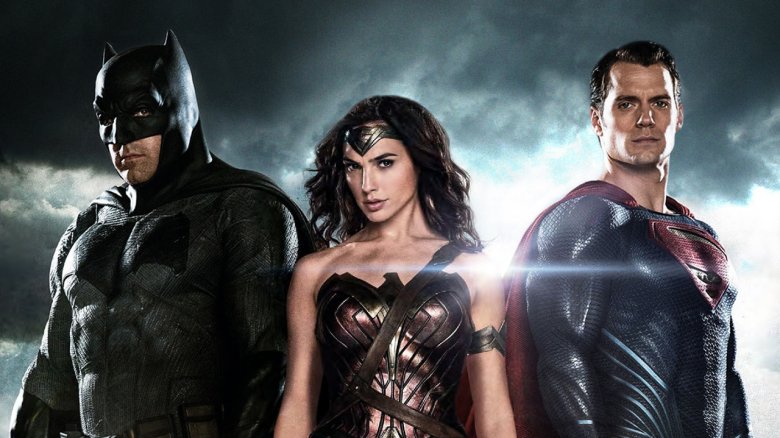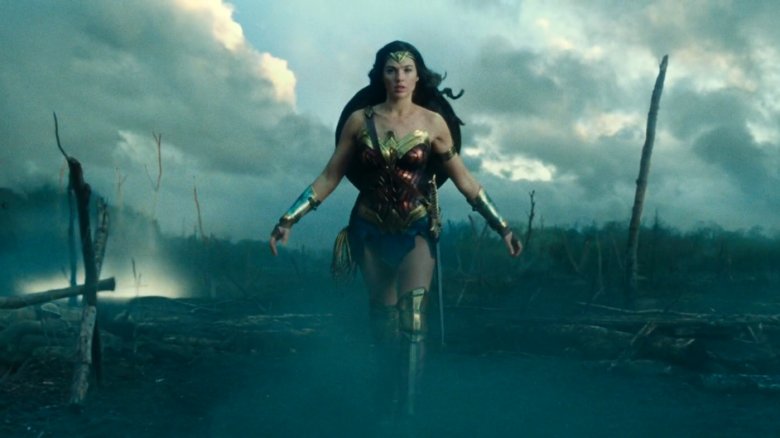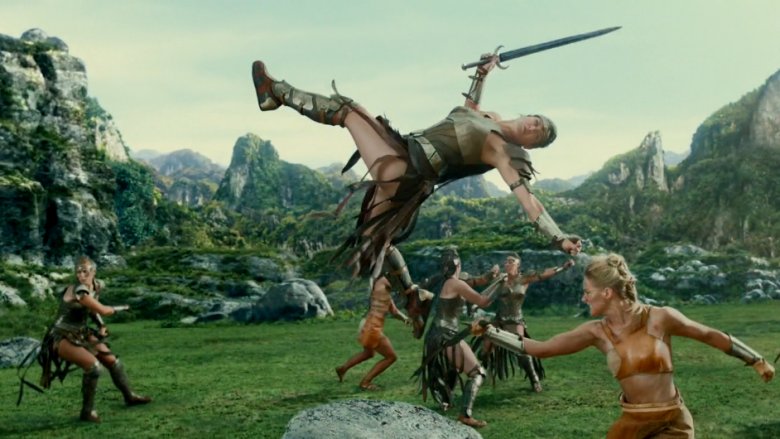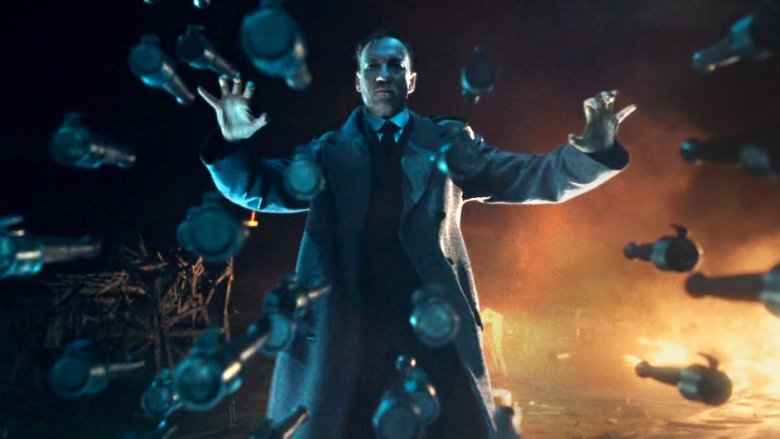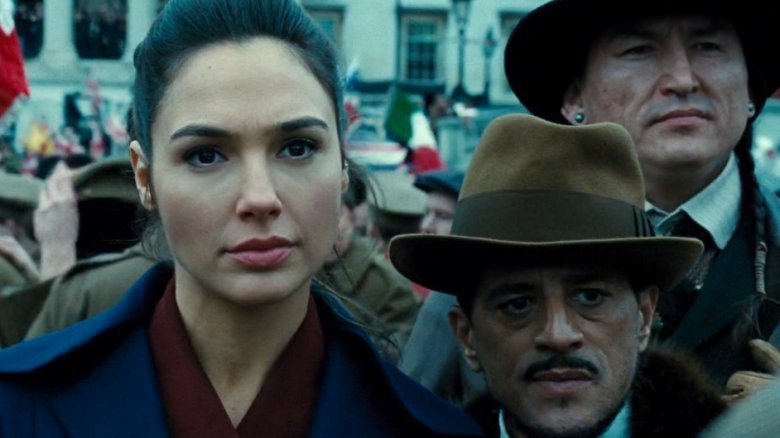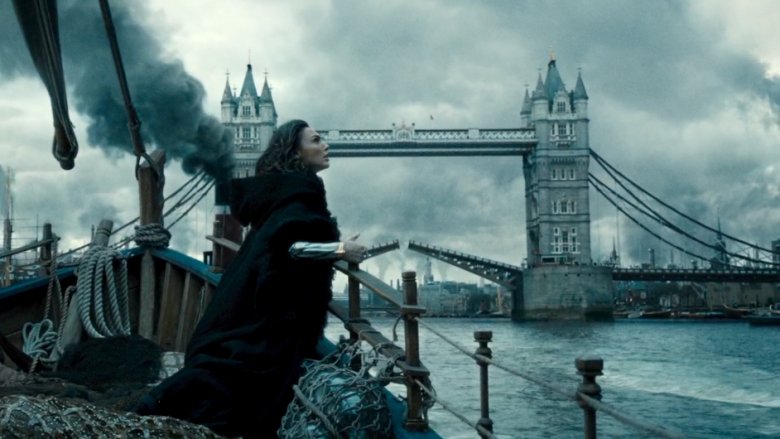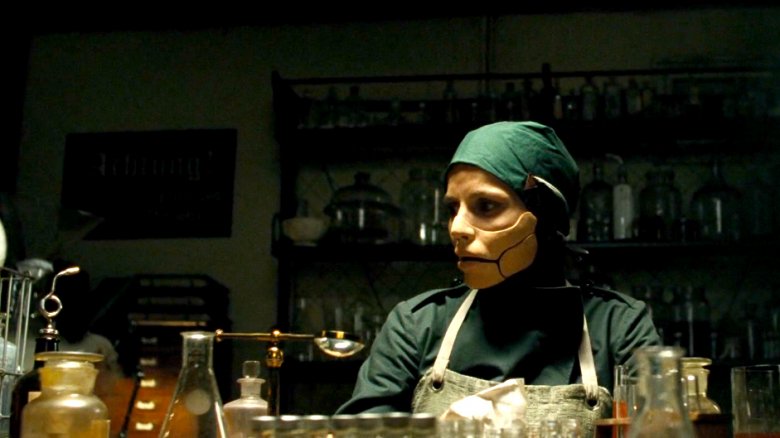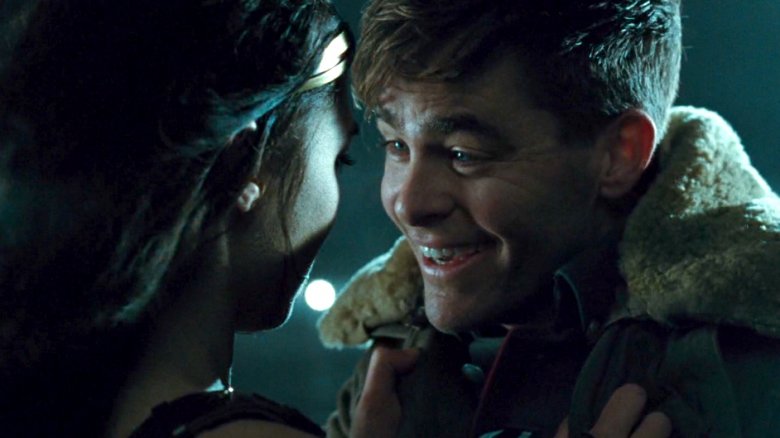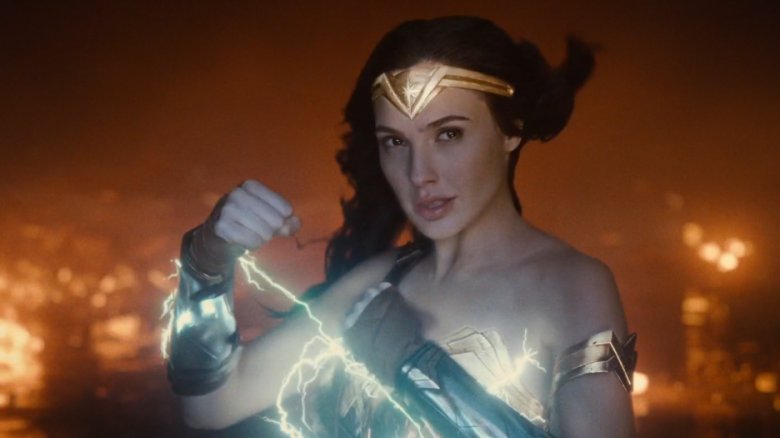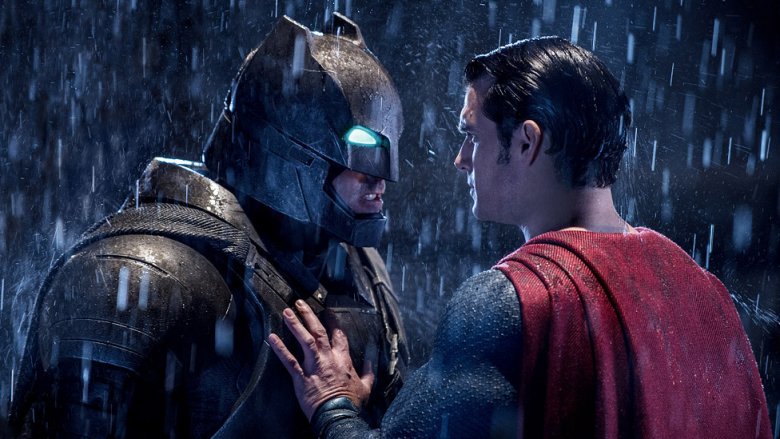How Wonder Woman Changed The DCEU And No One Noticed
Wonder Woman was the fourth film in the DC Extended Universe (or DCEU for short). The character of Princess Diana, a.k.a. Wonder Woman, made her debut in Superman v Batman: Dawn of Justice, played by Gal Gadot, who went on to star in the solo film and will continue to play the character in other DCEU movies. Wonder Woman came out in the summer of 2017, directed by Patty Jenkins with a screenplay by Alan Heinberg. From the first moment of its release (or even its prerelease buzz), it looked like it could be a game-changer. Not only was it the first female-led superhero movie since the genre really got going in 2008, it was immediately wildly popular on a level no previous DCEU movie had been.
There's a lot of stuff in Wonder Woman that's different — not just from the previous DCEU films, but most superhero movies that came before it. As a result, Wonder Woman seems likely to have a lasting effect on the DCEU, opening doors with regards to world-building and narrative. Here are ten ways Wonder Woman altered the DCEU that no one seemed to notice.
Move over, Superman and Batman
It's not hard to guess that the construction of the DCEU, starting in earnest with Batman v Superman: Dawn of Justice, was a response to the success of the MCU (Marvel Cinematic Universe). In fact, we'd probably be calling it the DCCU if that didn't look like a typo. The MCU started with 2008's Iron Man, then built through Iron Man 2, Captain America, and Thor (and technically The Incredible Hulk, although that one's the oddball with a completely different cast) before culminating in 2012's The Avengers.
Warner Bros., which owns DC Comics, clearly saw the success of that franchise and decided to do the same thing — but they wanted to do it much faster, which is at least semi-understandable, given that they'd already established their flagship characters through multiple franchises. 2013's Man of Steel was a new take on Superman, and its sequel, 2016's Batman v Superman, added the Caped Crusader to the mix as well as Wonder Woman. It even had cameos from Aquaman, Flash, and Cyborg. Heading toward Justice League, Warners clearly felt that connecting all these heroes was the way to get fans to see all the movies. Suicide Squad, which came out in 2016 as well, also featured brief appearances by Batman and Flash, while focusing on a collection of DCEU villains.
But Wonder Woman is different. A period piece set during World War I, it didn't have room for other superheroes. Bruce Wayne is referenced in the modern-day framing scenes, but otherwise, it's Princess Diana's show. And it was a huge box office success — it turns out that fans don't need to see Batman or Superman or Flash. It was a Wonder Woman movie, and fans showed up to see Wonder Woman.
A lack of cynicism
Man of Steel was an extremely dark and bloody take on the traditionally upbeat character of Superman, to the chagrin of some fans and critics. Batman v Superman took that even further, depicting two heroes who are traditionally friends as bitterly opposed for much of the movie. Suicide Squad was a movie about super-powered criminals forced into service by the government, so obviously it wasn't sunshine and rainbows either. Wonder Woman tells a different story.
It's violent, sure — it's a war movie. However, it depicts Wonder Woman as a symbol of hope. When she's first revealed in costume, stepping out into No Man's Land in the midst of the Great War, the emphasis is not that she's there to destroy people, although she does that when it needs doing. She's here to save people. She's come to make the world a better place — that's why she left Themyscira. In a world where Superman snaps a villain's neck and Batman brands criminals so they'll be killed in prison, Wonder Woman offers a refreshing return to the basic idea of a superhero, moving away from the idea that traditional heroism has lost its place.
Indulging fantasy
Whereas Superman is an alien and Batman is a guy with a lot of tech, Wonder Woman is a demigod with magical powers who grew up on an idyllic island where immortal women ride horses and train with swords and bows. Wonder Woman embraces fantasy elements to a degree that the DCEU really hadn't before. It's not the first DC movie to feature magic — Suicide Squad's villain is literally named the Enchantress — but Diana's origin takes it to another level. This is a movie that starts out in a purely fantasy setting before introducing the real world. Even Thor in the MCU interprets Asgard as more of a sci-fi realm in another dimension that merely inspired Earth mythology.
Wonder Woman doesn't hedge its bets like that. Diana grows up in something very much like an all-female version of Lord of the Rings. That doesn't just shape her abilities, but also her outlook. Her reaction to learning about the horror of World War I is to go on a quest to defeat a mad god. She's a superhero to be sure, but she's also a fantasy character, and that blend is carried off perfectly. Bringing her into a world that also features science-based heroes like Cyborg and the Flash creates endless possibilities for stories as well as future characters.
Gods among us
Ares, the main villain of Wonder Woman, isn't just named after the Greek god of war. For that matter, he's not just an alien from another dimension who the Greeks mistook for a god. Ares is literally the Greek god Ares, who you may have read about in high school. He's depicted as the last living god of Olympus, responsible for the deaths of the others. Nevertheless, even though Diana kills him by the end of the movie, the existence of this pantheon has vast implications for the larger world of the DCEU. Do the gods of other mythologies exist? If so, some of them are probably still around somewhere. What about Christian mythology? DC Comics features characters like the angel Zauriel and Etrigan the Demon. If Olympus exists in the DCEU, Heaven and Hell probably do too. There's no telling what metaphysical concepts might be introduced once you've established a world where mythological gods are not only real, they walk around on Earth looking like David Thewlis.
Hinting at history
In actual real-world history, Wonder Woman first appeared in comics in 1941. However, because comics continuity is constantly revised to keep everyone young, the version of Wonder Woman in the current comics only left Themyscira roughly ten years ago. The movie takes a different path — this Diana leaves during World War I, and has lived in the outside world for about a hundred years. We don't know what she did all that time, but we know she was around. As far as we know, Wonder Woman was the first superhero in this world. If she's been out there for a century, who else might have shown up along the way? There's a whole roster of DC Comics characters from the 1930s and 1940s, and with Wonder Woman setting the precedent, some of them might have existed even earlier in the DCEU. While we don't know that the movies will ever necessarily deal with much of that, a 100-year history of superheroes is rich with possibilities.
A super world
Unlike the comics version of Wonder Woman's origin, in which she leaves Themyscira to come directly to the United States, the movie version never takes Diana to America at all. That's most likely partly because of the World War I setting of the story, and also so it makes sense that Batman doesn't know much about her when they meet in Batman v Superman.
Instead, Diana sails directly from Themyscira to London. From there, she and her allies travel deeper into Europe to the Western Front of the war. Diana's still in Europe in the present, living in Paris and working at the Louvre Museum. This means Wonder Woman has not only established that DCEU superheroes exist across a vast span of time, but that they also exist all over the world. If Wonder Woman lives in Paris, which superheroes might live in Berlin? What about Tokyo, Johannesburg, or Mexico City? Rather than letting superheroes remain a largely American phenomenon, Wonder Woman makes them global.
Revitalizing the classic supervillain
Wonder Woman features three main villains: Ludendorff (Danny Huston) is a renegade German general who's addicted to war. Ares (David Thewlis) is the literal god. Perhaps the most exciting villain of all, at least for longtime fans, is Doctor Poison (Elena Anaya), the chemist who creates a deadly new kind of gas as well as poppers that grant super-strength. Doctor Poison was the first supervillain Wonder Woman fought in the comics, so featuring her so prominently in the first movie is a gift to fans.
More than that, however, she's one of the first supervillains in recent movies who really unironically lives up to many of the classic tropes. General Zod is often called a supervillain because he's very powerful and fights Superman, and while that's not technically inaccurate, his role in Man of Steel is really as the leader of an alien invasion, which is a bit different. The two Superman villains in Batman v Superman, Lex Luthor and Doomsday, are a corporate guy who wears normal clothes and a rampaging monster, respectively. Suicide Squad is filled with villains, of course, but they function more as antiheroes in that context (except for the Enchantress, but she's more like a Ghostbusters villain than anything else).
In contrast, Doctor Poison is a mad scientist in a green hooded outfit who hides her scarred face with a creepy mask. She kills random underlings in deadly experiments and laughs while tracing spiderweb cracks forming on a window as she watches people die on the other side. In short, she's a truly old school villain. Wonder Woman even spares her life, as comics superheroes have traditionally done for villains in comics — but more rarely in movies. Amidst all of the DCEU's attempts to make everything very modern, Doctor Poison shows that an old fashioned supervillain can still totally work.
A super romance
Superheroes tend to be monogamous and to mate for life, especially in movies. Superman will always end up with Lois. Aquaman and Mera weren't close in Justice League, but they'll 100 percent get together (and stay together) in the Aquaman movie. We already know Kiersey Clemons is playing Iris West in the Flash movie, making her romance with Ezra Miller's Barry Allen inevitable. Even Marvel heroes who've had multiple partners in the comics tend to focus on their original love interests in movies, whether it's Iron Man and Pepper Potts or Jane Foster and Thor. Natalie Portman, who plays Jane, didn't come back after Thor: The Dark World, and Thor simply hasn't had a romantic interest since. Admittedly, Batman is a bit of an exception since his obsessiveness about crimefighting makes him bad at relationships, but even he keeps coming back to Catwoman.
Similarly, Wonder Woman always gets paired in other media with her original love interest, Steve Trevor. He plays a key role in her origin, so obviously he's in the movie too, played by Chris Pine. However, since the movie is set a century in the past, there was never a chance for the two to live happily ever after, since she's immortal and he isn't. Ultimately the movie takes it even further, with Trevor sacrificing his life to destroy a plane full of Doctor Poison's gas after he and Diana kissed and even implicitly slept together. For a superhero's lover to die in a movie is almost unheard of, particularly for them to sacrifice their life heroically rather than be murdered by a villain or turn out to be one.
In addition to this narrative departure, Patty Jenkins has said that Wonder Woman will have a different love interest in the sequel. It'll reportedly be set in the 1980s, which means that whoever that person is, it will also likely only last for one movie. Depending on how long this goes on, Diana could become the first superhero since the '80s/'90s Batman to have a different love interest in every movie.
A killer of gods
Wonder Woman is the daughter of Zeus, and therefore a demigod. She's also referred to as the God Killer — a name she mistakenly applies to a sword before learning that the sword's not made for killing gods, she is. In addition to her super-strength, fighting ability, and prowess with her magic lasso, her god-killing power manifests in an ability to absorb and release vast amounts of destructive energy. Superman is probably physically stronger than her, but he can't do anything like that.
In Justice League, the arrival of Steppenwolf on Earth implies that Darkseid is on his way. Darkseid is a god in his own right, and if he does show up to fight the Justice League (despite the recent announcement that the New Gods are getting their own movie), there's probably only one hero who can deliver the final blow. At one time that would have seemed like Superman's job, but now it clearly falls to Wonder Woman.
A major shift in focus
Wonder Woman's power goes beyond her physical and mystical capabilities within the movies. As a character, she's proven to be more powerful than anyone expected, and so has her first movie. Wonder Woman wasn't just a huge success financially, it was a hit with critics — a feat managed by no previous DCEU movie. In the wake of its release, there was a lively public discussion on the internet and elsewhere about how the creative minds behind the DCEU had lessons to learn from Wonder Woman. It was too late to change much about Justice League, which came out only five months later, but going forward it's clear that it's Wonder Woman, not Superman or Batman, who will light the way forward for the DC superhero franchise. Until now, Superman and Batman have spent too much time fighting in the dark. Hopefully, that's about to change, thanks to a much-needed influx of wonder.
